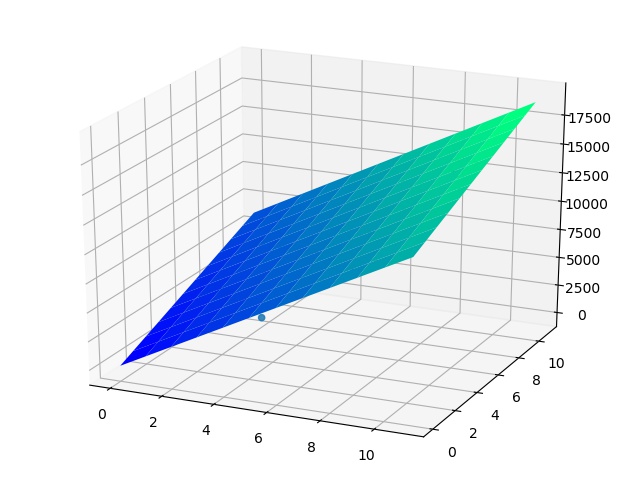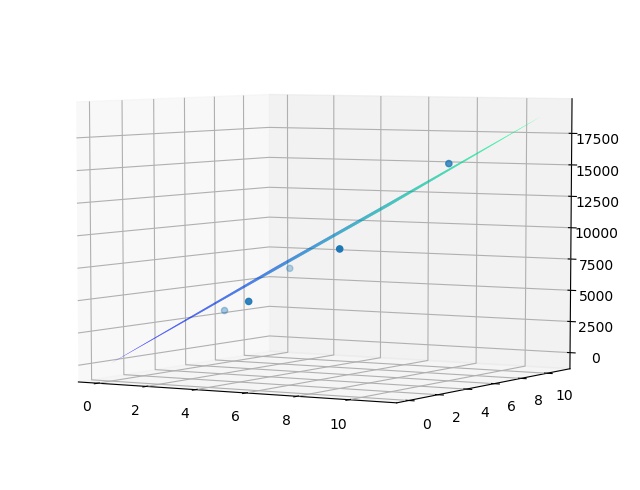功能:通过样本进行训练,让线性单元自己找到(这就是所谓机器学习)工资计算的规律,然后用两组数据进行测试机器是否真的get到了其中的规律。
原文链接在文尾,文章中的代码为了演示起见,仅根据工作年限来预测工资,参数是一维的,最后绘制的图也是平面图。本着学习的态度,我将代码改为能根据两个参数来预测工资,两个参数分别是工作年限和级别,并且用3D图绘制出拟合的效果。原作者的代码是适用于Python2.7的,我的代码适用于Python3,谨供参考。
注意:绘图代码需要安装matplotlib。
代码:
1 #!/usr/bin/env python 2 # -*- coding: UTF-8 -*- 3 4 from Perceptron import Perceptron 5 6 7 #定义激活函数f 8 f = lambda x: x 9 10 class LinearUnit(Perceptron): 11 def __init__(self, input_num): 12 '''初始化线性单元,设置输入参数的个数''' 13 Perceptron.__init__(self, input_num, f) 14 15 16 def get_training_dataset(): 17 ''' 18 捏造5个人的收入数据 19 ''' 20 # 构建训练数据 21 # 输入向量列表,每一项的第一个是工作年限,第二个是级别 22 # 构造这些数据所用的公式是:工资=1000*年限 + 500*级别,看机器是否能猜出来 23 input_vecs = [[5,1], [3, 7], [8,2], [1.5,5], [10,6]] 24 # 期望的输出列表,月薪,注意要与输入一一对应。【注意! 我故意让结果不太准确,这也会导致预测的结果有偏差】 25 labels = [5200, 6700, 9300, 3500, 15500] 26 return input_vecs, labels 27 28 29 def train_linear_unit(): 30 ''' 31 使用数据训练线性单元 32 ''' 33 # 创建感知器,输入参数的特征数为2(工作年限,级别) 34 lu = LinearUnit(2) 35 # 训练,迭代10轮, 学习速率为0.005 36 input_vecs, labels = get_training_dataset() 37 lu.train(input_vecs, labels, 10, 0.005) 38 #返回训练好的线性单元 39 return lu 40 41 42 def plot(linear_unit): 43 import numpy as np 44 from mpl_toolkits.mplot3d import Axes3D 45 import matplotlib.pyplot as plt 46 input_vecs, labels = get_training_dataset() 47 fig = plt.figure() 48 ax = Axes3D(fig) 49 ax.scatter(list(map(lambda x: x[0], input_vecs)), 50 list(map(lambda x: x[1], input_vecs)), 51 labels) 52 53 weights = linear_unit.weights 54 bias = linear_unit.bias 55 x = range(0,12,1) # work age 56 y = range(0,12,1) # level 57 x, y = np.meshgrid(x, y) 58 z = weights[0] * x + weights[1] * y + bias 59 ax.plot_surface(x, y, z, cmap=plt.cm.winter) 60 61 plt.show() 62 63 64 if __name__ == '__main__': 65 '''训练线性单元''' 66 linear_unit = train_linear_unit() 67 # 打印训练获得的权重 68 #print (linear_unit) 69 # 测试 70 print ('预测:') 71 print ('Work 3.4 years, level 2, monthly salary = %.2f' % linear_unit.predict([3.4,2])) 72 print ('Work 15 years, level 6, monthly salary = %.2f' % linear_unit.predict([15,6])) 73 plot(linear_unit)
为了代码的正常运行,你可能还需要下面这个感知机的类文件,另存为Perceptron.py(注意大小写),和上面的代码放在同一个目录下即可。
1 #coding=utf-8 2 3 from functools import reduce # for py3 4 5 class Perceptron(object): 6 def __init__(self, input_num, activator): 7 ''' 8 初始化感知器,设置输入参数的个数,以及激活函数。 9 激活函数的类型为double -> double 10 ''' 11 self.activator = activator 12 # 权重向量初始化为0 13 self.weights = [0.0 for _ in range(input_num)] 14 # 偏置项初始化为0 15 self.bias = 0.0 16 def __str__(self): 17 ''' 18 打印学习到的权重、偏置项 19 ''' 20 return 'weights :%s bias :%f ' % (self.weights, self.bias) 21 22 23 def predict(self, input_vec): 24 ''' 25 输入向量,输出感知器的计算结果 26 ''' 27 # 把input_vec[x1,x2,x3...]和weights[w1,w2,w3,...]打包在一起 28 # 变成[(x1,w1),(x2,w2),(x3,w3),...] 29 # 然后利用map函数计算[x1*w1, x2*w2, x3*w3] 30 # 最后利用reduce求和 31 32 #list1 = list(self.weights) 33 #print ("predict self.weights:", list1) 34 35 36 return self.activator( 37 reduce(lambda a, b: a + b, 38 list(map(lambda tp: tp[0] * tp[1], 39 zip(input_vec, self.weights))) 40 , 0.0) + self.bias) 41 def train(self, input_vecs, labels, iteration, rate): 42 ''' 43 输入训练数据:一组向量、与每个向量对应的label;以及训练轮数、学习率 44 ''' 45 for i in range(iteration): 46 self._one_iteration(input_vecs, labels, rate) 47 48 def _one_iteration(self, input_vecs, labels, rate): 49 ''' 50 一次迭代,把所有的训练数据过一遍 51 ''' 52 # 把输入和输出打包在一起,成为样本的列表[(input_vec, label), ...] 53 # 而每个训练样本是(input_vec, label) 54 samples = zip(input_vecs, labels) 55 # 对每个样本,按照感知器规则更新权重 56 for (input_vec, label) in samples: 57 # 计算感知器在当前权重下的输出 58 output = self.predict(input_vec) 59 # 更新权重 60 self._update_weights(input_vec, output, label, rate) 61 62 def _update_weights(self, input_vec, output, label, rate): 63 ''' 64 按照感知器规则更新权重 65 ''' 66 # 把input_vec[x1,x2,x3,...]和weights[w1,w2,w3,...]打包在一起 67 # 变成[(x1,w1),(x2,w2),(x3,w3),...] 68 # 然后利用感知器规则更新权重 69 delta = label - output 70 self.weights = list(map( lambda tp: tp[1] + rate * delta * tp[0], zip(input_vec, self.weights)) ) 71 72 # 更新bias 73 self.bias += rate * delta 74 75 print("_update_weights() -------------") 76 print("label - output = delta:" ,label, output, delta) 77 print("weights ", self.weights) 78 print("bias", self.bias) 79 80 81 82 83 84 def f(x): 85 ''' 86 定义激活函数f 87 ''' 88 return 1 if x > 0 else 0 89 90 def get_training_dataset(): 91 ''' 92 基于and真值表构建训练数据 93 ''' 94 # 构建训练数据 95 # 输入向量列表 96 input_vecs = [[1,1], [0,0], [1,0], [0,1]] 97 # 期望的输出列表,注意要与输入一一对应 98 # [1,1] -> 1, [0,0] -> 0, [1,0] -> 0, [0,1] -> 0 99 labels = [1, 0, 0, 0] 100 return input_vecs, labels 101 102 def train_and_perceptron(): 103 ''' 104 使用and真值表训练感知器 105 ''' 106 # 创建感知器,输入参数个数为2(因为and是二元函数),激活函数为f 107 p = Perceptron(2, f) 108 # 训练,迭代10轮, 学习速率为0.1 109 input_vecs, labels = get_training_dataset() 110 p.train(input_vecs, labels, 10, 0.1) 111 #返回训练好的感知器 112 return p 113 114 if __name__ == '__main__': 115 # 训练and感知器 116 and_perception = train_and_perceptron() 117 # 打印训练获得的权重 118 119 # 测试 120 print (and_perception) 121 print ('1 and 1 = %d' % and_perception.predict([1, 1])) 122 print ('0 and 0 = %d' % and_perception.predict([0, 0])) 123 print ('1 and 0 = %d' % and_perception.predict([1, 0])) 124 print ('0 and 1 = %d' % and_perception.predict([0, 1]))
正常运行的话,输出的预测结果是这样的:
预测: Work 3.4 years, level 2, monthly salary = 5125.02 Work 15 years, level 6, monthly salary = 20815.01

由上可见,本例中两个输入一个输出的线性单元拟合出来的是一个平面(因为预设的工资公式是线性的)。在旋转一个角度后看的更清楚:

原文链接:
https://www.zybuluo.com/hanbingtao/note/448086
文章写的很好,代码也漂亮,墙裂推荐大家看看原文。